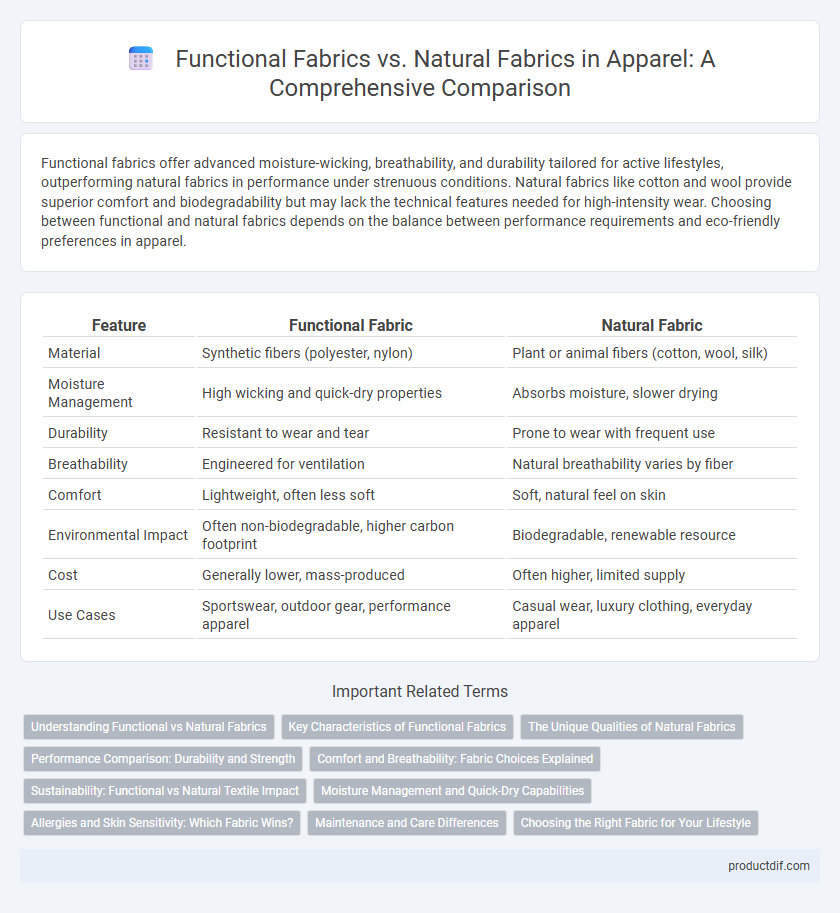Functional fabrics offer advanced moisture-wicking, breathability, and durability tailored for active lifestyles, outperforming natural fabrics in performance under strenuous conditions. Natural fabrics like cotton and wool provide superior comfort and biodegradability but may lack the technical features needed for high-intensity wear. Choosing between functional and natural fabrics depends on the balance between performance requirements and eco-friendly preferences in apparel.
Table of Comparison
| Feature | Functional Fabric | Natural Fabric |
|---|---|---|
| Material | Synthetic fibers (polyester, nylon) | Plant or animal fibers (cotton, wool, silk) |
| Moisture Management | High wicking and quick-dry properties | Absorbs moisture, slower drying |
| Durability | Resistant to wear and tear | Prone to wear with frequent use |
| Breathability | Engineered for ventilation | Natural breathability varies by fiber |
| Comfort | Lightweight, often less soft | Soft, natural feel on skin |
| Environmental Impact | Often non-biodegradable, higher carbon footprint | Biodegradable, renewable resource |
| Cost | Generally lower, mass-produced | Often higher, limited supply |
| Use Cases | Sportswear, outdoor gear, performance apparel | Casual wear, luxury clothing, everyday apparel |
Understanding Functional vs Natural Fabrics
Functional fabrics incorporate advanced technologies such as moisture-wicking, antimicrobial treatments, and stretch capabilities to enhance performance and durability in apparel. Natural fabrics like cotton, wool, and linen offer breathability, comfort, and sustainability but generally lack specialized features found in synthetic or blended materials. Choosing between functional and natural fabrics depends on usage requirements, with functional textiles ideal for activewear and natural fibers preferred for everyday comfort and eco-friendliness.
Key Characteristics of Functional Fabrics
Functional fabrics are engineered to enhance performance through moisture-wicking, breathability, and temperature regulation, making them ideal for activewear and outdoor apparel. These fabrics often incorporate synthetic fibers like polyester or nylon, which provide durability, stretch, and quick-drying properties. Advanced technologies such as antimicrobial treatments and UV protection further differentiate functional fabrics from natural fabrics, which primarily offer comfort and biodegradability but lack specialized performance features.
The Unique Qualities of Natural Fabrics
Natural fabrics such as cotton, wool, and silk offer exceptional breathability and moisture-wicking properties that enhance comfort in apparel. These fibers possess innate biodegradability, making them environmentally sustainable choices compared to synthetic alternatives. Their unique textures and hypoallergenic qualities contribute to superior skin sensitivity and durability in everyday wear.
Performance Comparison: Durability and Strength
Functional fabrics, engineered with synthetic fibers like polyester and nylon, offer superior durability and strength compared to natural fabrics such as cotton and wool. These advanced textiles resist tearing, abrasion, and moisture better, making them ideal for high-performance athletic and outdoor apparel. Natural fabrics, while breathable and comfortable, tend to wear out faster and lose structural integrity under intense use and repeated washing.
Comfort and Breathability: Fabric Choices Explained
Functional fabrics, engineered with moisture-wicking and quick-drying properties, provide superior breathability and temperature regulation compared to natural fabrics like cotton or wool. Natural fabrics excel in softness and hypoallergenic qualities, offering comfort through their organic fibers but may retain moisture longer. Selecting between functional and natural fabrics depends on activity level and climate, with functional options preferred for high-performance wear and natural materials favored for casual, everyday comfort.
Sustainability: Functional vs Natural Textile Impact
Functional fabrics often incorporate synthetic fibers like polyester or nylon, which are derived from petroleum and can result in higher carbon emissions and microplastic pollution during production and washing. Natural fabrics such as organic cotton, hemp, or linen tend to have a lower environmental footprint due to biodegradability and renewable sourcing but may require significant water and land resources depending on cultivation practices. Sustainable textile impact favors natural fabrics when grown with eco-friendly methods, whereas functional fabrics demand innovations in recycling and bio-based synthetics to reduce their ecological burden.
Moisture Management and Quick-Dry Capabilities
Functional fabrics integrate advanced moisture-wicking technologies that pull sweat away from the skin to the fabric surface, enabling rapid evaporation and keeping the wearer dry during intense activity. Natural fabrics like cotton absorb moisture but lack efficient quick-dry properties, often resulting in prolonged dampness and discomfort. Performance apparel increasingly favors synthetic fibers such as polyester and nylon due to their superior moisture management and quick-drying capabilities compared to natural alternatives.
Allergies and Skin Sensitivity: Which Fabric Wins?
Functional fabrics, often made from synthetic fibers such as polyester or nylon, are engineered to be moisture-wicking and breathable, reducing irritation for sensitive skin during physical activity. Natural fabrics like cotton, linen, and bamboo are hypoallergenic and less likely to cause allergic reactions, making them preferable for individuals with eczema or dermatitis. While functional fabrics excel in performance, natural fabrics generally win in minimizing allergies and skin sensitivity due to their organic, chemical-free composition.
Maintenance and Care Differences
Functional fabrics, often composed of synthetic fibers like polyester or nylon, require specific washing instructions such as cold water cycles and avoiding high heat to maintain moisture-wicking and durability properties. Natural fabrics like cotton, wool, or linen generally tolerate higher temperatures but may shrink or lose shape if not properly air-dried or ironed with care. Proper maintenance of functional fabrics preserves their specialized performance features, while natural fabrics benefit from gentle handling to sustain comfort and longevity.
Choosing the Right Fabric for Your Lifestyle
Functional fabric offers advanced moisture-wicking, breathability, and durability, ideal for active lifestyles requiring high performance and easy care. Natural fabrics such as cotton, wool, and linen provide superior comfort, breathability, and eco-friendliness, making them suitable for everyday wear and sensitive skin. Selecting the right fabric depends on your daily activities, climate, and personal preferences regarding comfort, maintenance, and sustainability.
Functional Fabric vs Natural Fabric Infographic

 productdif.com
productdif.com